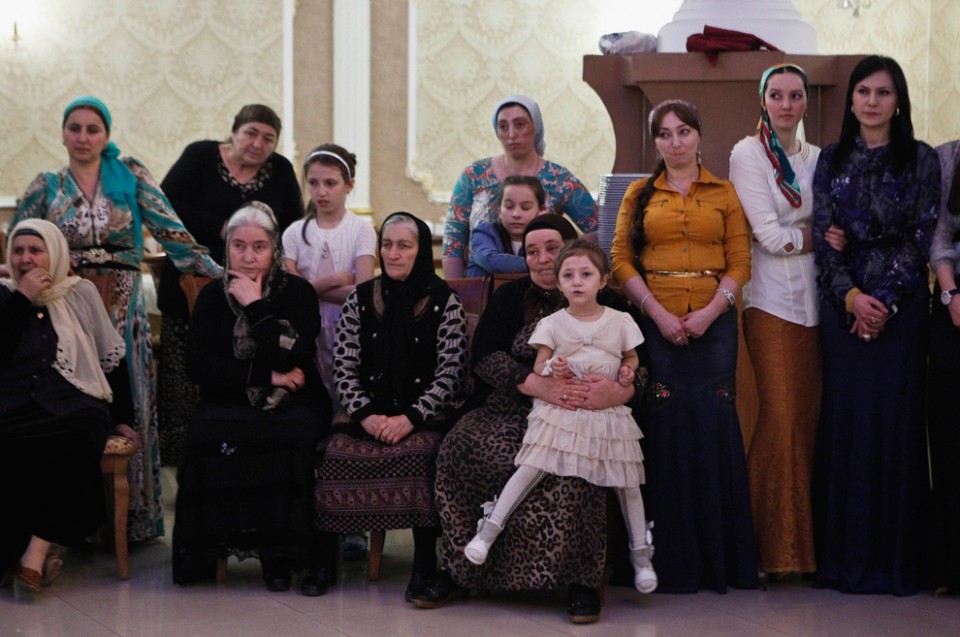
Fertility Rates in North Caucasus Falling and Growth Rates Soon Will as Well
Publication: Eurasia Daily Monitor Volume: 11 Issue: 22
By:

Despite widespread fears and even hysteria among Russians, fertility rates—the number of children per lifetime per woman—are falling among the peoples of the North Caucasus and now approach those of the Russian Federation as a whole. That reality, one commentator says, has been largely ignored because the growth rates of these nations remain high even though fertility rates are declining now and will push down growth rates in the future.
One of the “boogeymen” Russian media and politicians often invoke is “the myth about the super-high fertility of the Caucasian peoples, which supposedly will lead to a situation in which they will fill up all of Russia and drive out the ethnic Russian population,” Iera Ramazanova writes on the Lezgin portal, FLNKA.ru (flnka.ru/aktualnoe/5316-demograficheskie-mify-kavkaza.html).
Nationalist politician Vladimir Zhirinovsky’s recent suggestion that high birthrates in the North Caucasus are responsible for the growth of extremism and terrorism in the region is only the most “absurd” expression of such ideas, but it is hardly unique. Similar thinking on offer in Moscow appeared this week on the portal rus-obr.ru, for example (rus-obr.ru/ru-web/29271).
For most of the last 20 years, Russia has been experiencing a decline in population. The situation appeared to stabilize in 2012, and “some demographers calculate that in 2013, there [would] be long-awaited growth.” Full statistics have not yet been published, so that remains unclear; but even if there is an uptick just now, the age structure of the population is going to depress overall growth rates in the future, and consequently, Russians should not be celebrating any fundamental shift, Ramazanova points out (flnka.ru/aktualnoe/5316-demograficheskie-mify-kavkaza.html).
Compared to Russia as a whole, she continues, “many Caucasian republics are distinguished by a relatively high birthrate and natural growth,” especially Chechnya and Ingushetia, according to statistics their officials offer. But Ramazanova says many experts doubt the reliability of those statistics because the growth rates in other republics in the region are much lower. In Dagestan, for example, the birthrate is just slightly more than in Yamalo-Nenets and in fact is slightly less than in Tyva. And in other North Caucasus republics, the birthrate was even lower.
The difference between the situation in Russia as a whole and the North Caucasus in particular reflects not so much a higher birthrate in the latter than in the former but the existence of many more women in the prime childbearing cohort in the latter as a result of significantly higher birthrates earlier. Beginning in the 1960s, ethnic Russians had fewer children than needed for replacement of the population while non-Russians in the North Caucasus still had more. If Russians had two children per household in the first of these generations and non-Russians had four or more, there are now simply more women as a share of the population in the latter, even if birthrates are declining in both. Consequently, for the time being, overall population growth in percentage terms is higher in the North Caucasus than among ethnic Russians, but it is falling and will continue to do so, as the number of children per woman declines with each generation.
Another factor that affects outcomes in this regard is the measure of how many young women born to each woman in a population over her lifetime live to give birth to an equal number of women by the younger group. “If it exceeds one, then the number of women and the population as a whole will grow; if it is lower, then there will be a negative trend” (flnka.ru/aktualnoe/5316-demograficheskie-mify-kavkaza.html).
For Russia as a whole, this figure is 0.8: which means that the next generation will be 80 percent as large as that of the current one. In rural areas, however, the figure is 1.05 which means that there is still some growth. Among non-Russian regions, this figure is above replacement in Buryatia (1.004), Sakha (1.03), Ingushetia (1.05), Nenets (1.11), the Altay Republic (1.37), Chechnya (1.46) and Tyva (1.55). Everywhere else the figure is less than one and the population is now declining or soon will. Dagestan, for example, comes in at 0.968 and thus is already on the path to decline.
If nothing changes—and Ramazanova notes that “world practice shows that it is impossible to stop this trend”—then “in the coming decades, the population of Dagestan will cease to grow and then begin to decline.” That is true elsewhere in the North Caucasus as well. And even in Chechnya it is probable that the rate of growth is not nearly as high as officials, who use such numbers to extract more money from Moscow, currently claim.
This trend means, Ramazanova says, that the North Caucasians are not about to overwhelm the Russians on the basis of their birthrates alone and that Moscow should provide support for motherhood in that region just as much as it does elsewhere.




